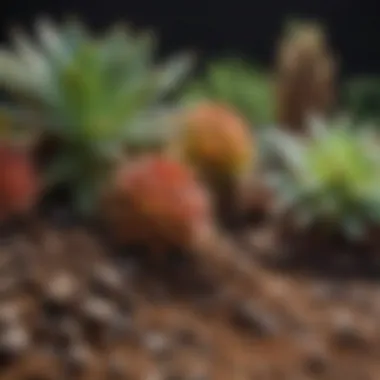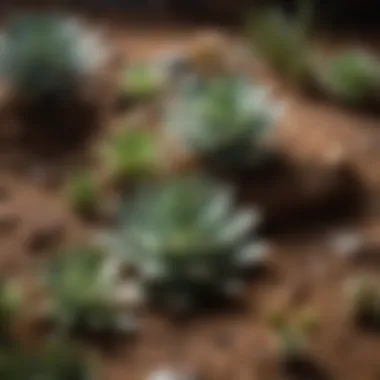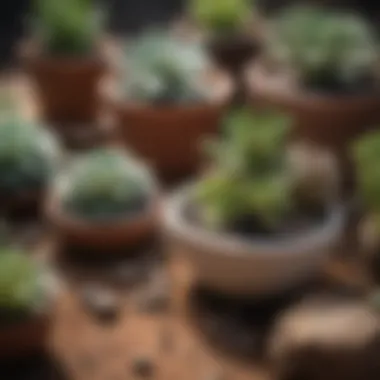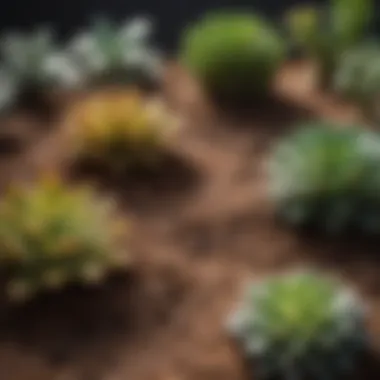Choosing the Best Potting Soil for Succulents


Intro
Selecting the right potting soil is crucial for the health and growth of succulents. These unique plants, adapted to thrive in arid conditions, have specific needs that set them apart from traditional houseplants. Understanding these requirements can prevent overwatering, root rot, and other issues often encountered by growers. This article provides a thorough overview of the essential characteristics of potting soil tailored for succulents.
Succulents typically need well-draining soil that retains some moisture but does not become soggy. The right combination of ingredients ensures adequate aeration and drainage while allowing the plants to absorb necessary nutrients. In the upcoming sections, we will cover the characteristics of suitable soil mixtures, examine commercial products on the market, and explore homemade options. We will also address factors such as drainage capabilities, aeration, and nutrient content, which are vital for optimal plant performance. By synthesizing expert recommendations and current research, this guide aims to empower both novice and experienced succulent enthusiasts with the knowledge necessary to foster strong, healthy growth.
Understanding the Needs of Succulents
Succulents, with their unique adaptations to arid environments, possess distinct needs that set them apart from other plant varieties. Recognizing these needs is crucial for anyone seeking to cultivate vibrant and thriving succulents. The right potting soil plays a significant role in ensuring their health and overall well-being.
In this section, we will explore the critical aspects of succulent biology and growth patterns that inform the optimal selection of potting soil. By understanding these elements, growers can tailor their soil choice to support the specific demands of their plants, facilitating better growth and resilience.
Defining Succulents
Succulents are characterized by their fleshy, water-storing tissues that enable them to retain moisture in dry conditions. This adaptation is primarily what allows them to survive in environments where water is scarce.
Many species belong to this category, including aloe vera, jade plants, and various types of cacti. Each of these plants exhibits unique characteristics and growth behaviors that call for specific care measures. Importantly, succulents can be further categorized into two main families: Crassulaceae and Cactaceae, both of which have different environmental and soil requirements.
Growth Patterns and Environment
Succulents thrive in specific growth environments that mimic their native habitats. Most originate from regions such as deserts and dry mountains, where soil composition tends to be loose and well-draining. This aspect is essential when contemplating potting soil selection.
- Sunlight: Succulents generally require plenty of sunlight. Many prefer bright, indirect light while some enjoy direct exposure. Understanding the light preference helps manage their placement, allowing for proper growth without burning the foliage.
- Soil Composition: The unique structures and water storage capabilities of succulents necessitate soil with excellent drainage properties. Heavy soils can lead to root rot, which occurs when roots sit in waterlogged conditions for prolonged periods.
- Water Needs: These plants have adapted to endure extended dry periods. As a result, their watering regimens should reflect their ability to store water. Too much moisture can be detrimental, emphasizing the need for soil that facilitates rapid drainage.
By grasping the definition and growth patterns of succulents, as well as their environmental preferences, one can make informed decisions about potting soil selection. This awareness helps to eliminate guesswork, contributing to healthier plants and a more rewarding growing experience.
"Understanding the specific needs of succulents is fundamental for successful cultivation and health of the plants."
The Importance of Potting Soil Composition
Potting soil composition is fundamental when it comes to the successful cultivation of succulents. Understanding the right soil mix not only enhances the growth potential of these plants but also mitigates common issues that arise in their care. The composition of potting soil directly influences factors like moisture retention, root stability, and nutrient availability. Thus, selecting the appropriate soil mix is paramount for ensuring robust and healthy succulents.
A well-composed potting soil provides essential support, allowing roots to breathe and preventing waterlogged conditions. When soil retains too much moisture, it creates an environment conducive to root rot, a prevalent issue for many succulent enthusiasts. Therefore, discerning the components of potting soil is critical for maintaining the delicate balance these plants need.
Additionally, adequate drainage and aeration are key components to consider. Succulents thrive in environments where excess water can easily escape, thus preventing the roots from sitting in water. The choices made in soil composition will have lasting implications for plant health, reinforcing the idea that understanding these elements can ultimately dictate the success of succulent care.
Role of Soil in Plant Health
Soil serves as the foundation for plant health. For succulents, the right soil promotes oxygen flow to the roots while regulating moisture levels. Core roles of soil include:
- Nutrient Delivery: Soil acts as a medium that contains essential nutrients plants require for photosynthesis and growth.
- Water Management: It regulates water availability, preventing both drought stress and water logging.
- Support Structure: Good soil composition provides stability for roots, allowing plants to anchor properly.
The health of the soil directly correlates with plant vigor. A nutritious, well-drained soil fosters stronger growth and improves overall resilience.
Key Components of Potting Soil
When selecting potting soil for succulents, it is important to consider the individual components that make up the mix. These components can include:
- Cactus Mix: A commercial option designed for desert plants, often featuring gritty materials for drainage.
- Perlite: A volcanic glass that enhances aeration and drainage, making it an excellent addition to potting soil for succulents.
- Coconut Coir: This sustainable material holds moisture and helps to maintain a balanced environment without becoming overly water-retentive.
- Sand: Coarse sand adds grittiness, improving drainage and air circulation.
Each of these components plays a role in creating a conducive environment for succulents, ensuring they can thrive in their intended settings. Balancing these elements is vital to develop a potting soil composition that not only supports growth but also prevents issues often seen in poorly drained soils.
Essential Characteristics of Succulent Potting Soil
When selecting potting soil for succulents, it is vital to consider certain essential characteristics. These factors significantly influence the health and growth of these unique plants. Succulents, unlike many other plants, have special needs due to their water-storing capabilities and specific environmental preferences. Hence, understanding these characteristics is fundamental to ensuring optimal growth and longevity for succulents.
The primary focus should be on drainage, aeration, and nutrient retention. Each of these elements contributes to the overall well-being of succulents, helping to prevent common issues such as root rot and nutrient deficiencies. As you delve into each characteristic, you will see how they directly align with the ideal conditions required for succulent care.
Drainage Capability


The first characteristic to evaluate in a succulent potting soil is its drainage capability. Succulents thrive in environments with well-draining soil to avoid excess moisture, which can lead to root rot. Waterlogged soil can suffocate roots, creating an unsuitable environment for the plant's growth.
To ensure proper drainage, the soil should consist of 60% inorganic to 40% organic materials. Materials such as perlite, pumice, and coarse sand are excellent choices for enhancing drainage. When creating your soil mixture, it is important to test the water retention efficiency. Simply pour water into the soil mixture and observe how quickly it passes through. Fast drainage is ideal for most succulents.
Aeration and Root Health
Another critical aspect is aeration. Well-aerated soil allows roots to access oxygen, which is essential for healthy growth. Succulents adapt to dry, arid environments, meaning their roots often must absorb moisture quickly when available. Therefore, a soil mixture that promotes aeration supports root health by preventing compaction.
To achieve optimal aeration, you can incorporate materials like coconut coir or shredded bark. These ingredients help create pockets of air within the soil structure. A mix that allows for airflow also helps to minimize the risk of developing root diseases, which are more prevalent in dense soils. Monitoring this factor can lead to more vigorous growth and resilient plants.
Nutrient Retention
Nutrient retention is the final characteristic to consider when selecting potting soil for succulents. While succulents do not require extremely nutrient-rich soil, they still need sufficient nutrients to thrive. Components like organic matter, such as compost or well-rotted granular fertilizers, can be beneficial. These additives can provide necessary minerals, aiding overall plant health without overwhelming the roots.
When choosing a soil mix, look for those with balanced nutrient retention. Over-fertilization can cause stress on succulents and lead to uneven growth. Follow recommended guidelines for fertilization, ensuring it aligns with the plant's growing season.
"Understanding these characteristics not only improves overall plant health but also empowers growers to make informed decisions about their succulent care."
By carefully considering drainage capability, aeration, and nutrient retention, you can create an optimal environment for your succulents. Ensuring these properties are balanced in your potting soil will foster robust growth and increased resilience against adverse conditions.
Commercial Options for Succulent Potting Soil
Commercial options for succulent potting soil provide a practical solution for both novice and experienced succulent growers. These pre-mixed options are designed specifically to cater to the unique requirements of succulents, ensuring that vital characteristics such as drainage, aeration, and nutrient balance are optimized. By selecting a quality commercial mix, growers can save time and effort, allowing them to focus more on plant care rather than soil formulation. However, it is essential to understand the various available products and how they can affect succulent health.
Pre-Packaged Succulent Mixes
Pre-packaged succulent mixes are readily available at garden centers and online stores. These blends are formulated with a focus on the distinct needs of succulents and cacti. The ingredients commonly include components like peat moss, perlite, and coarse sand. Each ingredient plays a crucial role:
- Peat Moss: Provides minimal moisture retention, reducing the risk of root rot.
- Perlite: Enhances drainage and aeration, allowing roots to breathe.
- Coarse Sand: Improves soil structure and also contributes to drainage.
Many commercial mixes come specially tailored by brands such as Miracle-Gro or Black Gold, promoting proper root development and overall plant vigor. When choosing a mix, be sure to look for phrases like "for cacti and succulents" on the label. This ensures that the product aligns with the necessary specifications for optimal growth.
Considerations
While pre-packaged succulent mixes offer convenience, it is critical to assess the quality. Some products may contain additives such as fertilizers or moisture-retaining granules that do not align with the needs of succulents. Always read the ingredient list to ensure it meets the specific requirements for your plants.
Recommendations from Experts
Experts in horticulture often recommend specific brands or formulations known for their effectiveness in succulent cultivation. For instance, many succulent enthusiasts and specialists quote highly about brands like Espoma and Roots Organics, which utilize high-quality materials and avoid excessive fillers.
"Using a well-balanced commercial soil mix can significantly reduces the risk of overwatering, a common issue among succulent growers."
— A Horticulture Expert
It can also be beneficial to consult online communities such as Reddit or specialized succulent forums. Many enthusiasts share their experiences with different products and can highlight lesser-known brands that might perform even better than mainstream options.
Finding an appropriate commercial option requires research and consideration of individual succulent species. It is advisable to take notes on how specific mixes perform over time, adjusting choices according to the results observed in your plants. By integrating expert recommendations and firsthand experiences, you can select a potting soil that enhances the health and appearance of your succulents.
Creating Your Own Potting Soil Blend
Creating your own potting soil blend is essential for ensuring the optimal growth and health of your succulents. While commercial mixes can provide a good starting point, making your own allows for customization that aligns directly with the specific needs of these resilient plants. Tailoring the soil can improve drainage, aeration, and overall nutrient retention. This flexibility is particularly helpful for novice gardeners or those who want to create the perfect environment for their succulents.
Essential Ingredients
When crafting your own potting soil, there are several key ingredients to consider:
- Cactus Mix: This serves as a base, usually comprised of a sandy blend that facilitates drainage.
- Perlite or Pumice: These aerating agents increase the soil's porosity, ensuring roots do not suffocate.
- Coconut Coir or Peat Moss: They help retain moisture without becoming overly saturated, thus supporting nutrient uptake.
- Sand: A coarse type of sand is ideal as it promotes drainage and mimics the natural desert habitat of succulents.
Utilizing a mixture of these components will create a balanced, well-draining medium that helps foster succulent growth.
Step-by-Step Mixing Process


The mixing process is straightforward and can be completed in a few simple steps:
- Gather Your Ingredients: Measure out the desired quantities of cactus mix, perlite, coconut coir, and sand.
- Prepare a Mixing Container: Use a clean bucket or wheelbarrow for easy stirring.
- Combine Dry Ingredients: In the container, mix equal parts cactus mix, perlite, and coconut coir. Then, add a smaller amount of sand to enhance drainage. Aim for a ratio of about 2:1:1, respectively, depending on the specific needs of your plants.
- Mix Thoroughly: Using a trowel or shovel, ensure all components are evenly distributed. This step is crucial as it guarantees that each handful of soil will provide the same drainage and nutrient availability.
- Test the Mix: Before potting, take a small amount and moisten it slightly. If it clumps but breaks apart easily, you have achieved a good balance. Adjust as necessary for optimal consistency.
Perhaps you invest time in creating your own blend will not only help enhance your succulent's life span but will also teach you more about their needs and soil science. This enriching experience pays off in thriving healthy plants.
Additional Amendments for Enhanced Performance
When selecting potting soil for succulents, one must consider various amendments that can significantly enhance the soil's performance. These amendments contribute to better drainage, aeration, and nutrient retention. Each component serves a unique purpose, ensuring the growing environment meets the specific needs of succulents. Understanding how to optimize potting soil through appropriate amendments is crucial for both novice and experienced gardeners.
Perlite and Pumice
Perlite and pumice are two common amendments used to improve the drainage and aeration of potting soil. Perlite is a volcanic glass that is heated and expanded to create lightweight white particles. It is known for its ability to retain moisture while allowing excess water to drain freely. This feature is particularly beneficial for succulents which can be prone to root rot if left in soggy conditions.
On the other hand, pumice is a naturally occurring volcanic rock that has a porous structure. It provides similar benefits to perlite, enhancing the soil's ability to drain. However, pumice is heavier and denser, offering some anchorage to the roots. Using a combination of these two materials can create an ideal environment for succulent growth.
Benefits:
- Improved Drainage: Both perlite and pumice facilitate efficient drainage, reducing the risk of overwatering.
- Enhanced Aeration: These amendments provide spaces within the soil for air to reach the roots, promoting healthy growth.
- Lightweight: Perlite is particularly advantageous for container gardening, as it keeps the overall weight of the pot down.
Incorporating perlite and pumice into your potting mix will greatly enhance its performance and support succulent health.
Coconut Coir and Sand
Coconut coir and sand are additional amendments that can be utilized for creating an effective potting mix for succulents. Coconut coir is derived from the fibrous husks of coconuts. It helps retain moisture while ensuring aeration, making it a versatile additive. This organic material can improve the soil's water-holding capacity without making it overly dense.
Sand is another significant component that aids in drainage. Coarse sand, particularly, allows excess moisture to escape while holding some moisture for the roots to absorb. However, it is important to use the correct type of sand, as some varieties can compact too tightly, leading to poor drainage.
Benefits:
- Water Retention: Coconut coir can retain moisture effectively, which is beneficial in dry conditions.
- Reduced Compaction: A mix including coir and coarse sand reduces the likelihood of soil compaction, allowing roots to spread more easily.
In essence, combining coconut coir and sand into your potting soil mix can create an optimal environment for succulent growth while ensuring that water management is efficient.
It is evident that the right amendments not only boost drainage and aeration but also contribute to the overall health of succulents. Understanding how each component interacts with one another will help in creating a robust potting medium.
Environmental Considerations in Potting Soil Choice
Choosing the right potting soil for succulents goes beyond basic soil characteristics. Environmental considerations play a crucial role in ensuring optimal growth. These factors can influence the success of the plants in various direct and indirect ways. Being mindful of the environment promotes healthier plants, sustainability, and potentially better yields.
Impact of Soil pH
Soil pH is a vital parameter in potting soil. Succulents prefer a slightly acidic to neutral pH, usually between 6.0 and 7.0. Understanding pH levels is critical because they directly affect nutrient availability. For example, calcium and magnesium are absorbed effectively at this pH range.
An incorrect pH can lead to nutrient deficiencies even if the nutrients are present in the soil. Thus, testing soil pH before planting is advisable. Various methods exist, indeed, such as using pH testing kits available at gardening centers. If adjustments are necessary, one can amend the soil using substances like elemental sulfur to lower pH or lime to raise it.
Watering Practices and Soil Type
Different soils require distinct watering practices. Succulent potting soil should promote drainage and aeration. Overly compacted or heavy soils retain too much moisture, leading to root rot. Conversely, well-draining mixes made up primarily of materials like perlite or coarse sand enable water to flow through easily.
Changing how one waters succulents can also enhance soil performance. This involves adjusting both frequency and method. For most succulents, soaking the soil and allowing it to dry completely before the next watering is ideal. Such practices help maintain the balance between adequate moisture and adequate drainage, critical for the health of these plants.
Ultimately, choosing suitable soil based on these elements is necessary. Environmental factors like soil pH and watering practices directly impact the overall health of succulents. Thus, careful attention to selection can foster robust and thriving plants while also respecting the broader ecosystem.
Testing and Adjusting Potting Soil
Testing and adjusting potting soil is fundamental for succulent health. Different types of succulents have unique needs, which means the soil must cater to specific conditions. The significance of this section cannot be overstated. Proper soil ensures that plants thrive, preventing issues such as rot or nutrient deficiencies. This ensures that an optimal growing environment is maintained for your succulents.
Soil Testing Methods


Soil testing is a critical first step before adjusting any properties. There are several reliable methods to test the potting soil, helping you understand its current state and composition. The most common methods include:
- pH Test Kits: This measures the acidity or alkalinity of the soil. Succulents generally prefer a slightly acidic to neutral pH, around 6.0 to 7.0.
- Moisture Meters: These devices help indicate the moisture level in the soil, ensuring it aligns with the needs of your plants. Overly moist soil can be harmful to succulents.
- Texture Tests: Understanding the soil texture aids in evaluating drainage and aeration. A simple feel test can show if the soil is too compacted.
- Nutrient Testing Services: Sending soil samples to laboratories provides detailed reports on nutrient content. This is particularly beneficial for serious growers.
Using these methods collectively provides a comprehensive view of the soil's qualities and reveals what adjustments may be necessary.
Adjusting Soil Properties
Once the soil has been tested, adjustments can be implemented. Several key properties can be modified to create an optimal environment for succulents:
- pH Adjustment: If the pH level is outside the desired range, amendments can be made. Adding lime raises pH, while adding sulfur can help lower it.
- Improving Drainage: To enhance drainage, incorporating materials such as perlite or coarse sand is effective. This prevents water retention, which is crucial for succulent root health.
- Aeration: For soil that is too compacted, mixing in organic matter like coconut coir can improve airflow. It ensures roots are not suffocated.
- Nutrient Enhancement: For nutrient-poor soil, slow-release fertilizers or organic amendments like compost can enrich the soil without overwhelming the plants.
Adequate testing and thoughtful adjustments lead to a healthier, more resilient succulent garden.
By continuously assessing and modifying the soil, you foster a thriving environment for your succulents, ensuring they flourish in their potting situations.
Troubleshooting Common Soil Issues
Understanding how to troubleshoot common soil issues is essential for maintaining the health and vitality of succulents. Despite adequate light and care, a poor potting soil choice can lead to significant plant stress. This section will address common obstacles that succulent growers face, as well as methods for identifying and remedying these problems.
Identifying Poor Drainage
Poor drainage is a prevalent issue for succulent enthusiasts. When soil retains too much moisture, it can lead to root rot, a common ailment for these drought-resistant plants. Recognizing the signs of poor drainage involves observing watering patterns and the condition of the plant itself.
Signs of Poor Drainage:
- Yellowing Leaves: This may indicate excess water in the soil.
- Mushy or Blackened Roots: This is a clear signal of root rot.
- Water Pooling on Surface: Soil that does not absorb water effectively can also lead to this issue.
To alleviate drainage problems, consider the following actions:
- Amend the Soil: Adding materials like perlite or pumice can help improve drainage.
- Repot Your Succulent: If the issue persists, it may be necessary to repot using a different soil mix that has better drainage properties.
- Select Appropriate Containers: Ensure pots have drainage holes to prevent water buildup.
Nutrient Deficiencies and Remedies
Another common problem for succulent growers is nutrient deficiencies. Each succulent may have different nutrient needs, depending on its species and growth stage. Deficiencies can negatively affect growth and overall plant health.
Signs of Nutrient Deficiencies:
- Stunted Growth: Lack of growth or small leaf sizes can indicate a shortage of nutrients.
- Pale or Discolored Leaves: This may suggest insufficient nitrogen or other essential nutrients.
- Leaf Drop or Shriveling: These symptoms could point to several deficiencies, usually linked to nutrient imbalance.
To address these deficiencies, several remedies can be applied:
- Fertilization: Use a balanced fertilizer designed for succulents. Follow the product’s instructions regarding application frequency and concentration to avoid over-fertilization.
- Soil Testing: Conducting a soil test can provide precise data on nutrient levels, enabling targeted amendments.
- Homemade Remedies: Solutions like diluted liquid kelp or compost tea can serve as effective natural fertilizers to enhance nutrient content.
"Understanding the symptoms of poor drainage and nutrient deficiencies in succulents prepares growers to take informed action, ensuring their plants thrive in optimal conditions."
By skillfully observing your plants and properly diagnosing their needs, you can significantly improve your growing experience. Engaging in troubleshooting strategies not only enhances your skill but is essential in cultivating a robust and healthy succulent collection.
End: Best Practices for Succulent Potting Soil
Selecting the right potting soil for succulents is a critical aspect of successful cultivation. The nature of succulents’ growth demands a tailored approach to their habitat, primarily focusing on drainage, aeration, and nutrient balance. Optimal soil selection can significantly enhance plant growth, health, and longevity, making understanding best practices essential.
One key element to remember is that not all potting soils are created equal. The ideal succulent potting soil should prioritize drainage to prevent root rot, a common concern among succulent growers. Choose a mix that consists of materials like perlite, pumice, or coarse sand, which help facilitate proper drainage.
In addition to drainage, aeration is crucial. Succulents require oxygen at their root systems to thrive. Soils should be light and airy, enabling roots to breathe while also providing the necessary structure for healthy growth.
Recommended Components for Mixing
- Cactus Mix: Often formulated specifically for succulents, this mix typically contains a small amount of organic matter alongside robust aggregates for drainage.
- Homemade Blends: Creating your own mix is another effective way to ensure the soil meets specific needs. A blend of equal parts coarse sand, perlite, and potting soil can yield excellent results.
Nutrient retention is another essential consideration. While succulents do not thrive in nutrient-rich environments, they do need some access to nutrients. A balanced approach is recommended, wherein slow-release fertilizers can be incorporated into the mix without overwhelming the plant.
"Finding the right balance in potting soil composition is pivotal for ensuring succulents receive exactly what they need for optimal growth."
Practical Considerations
- Avoid over-fertilizing: Too many nutrients can hurt succulents. Fertilize during the growing season at minimal rates.
- Regularly check soil moisture: Water only when completely dry to the touch. Succulents benefit from periodic dryness.
- Adjust based on plant type: Different succulents have varied needs. Adapt your mix for specific species accordingly.







